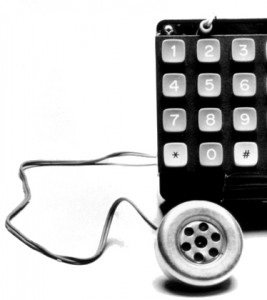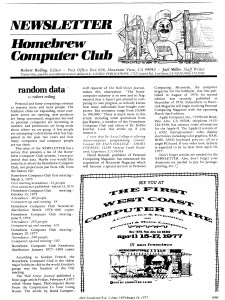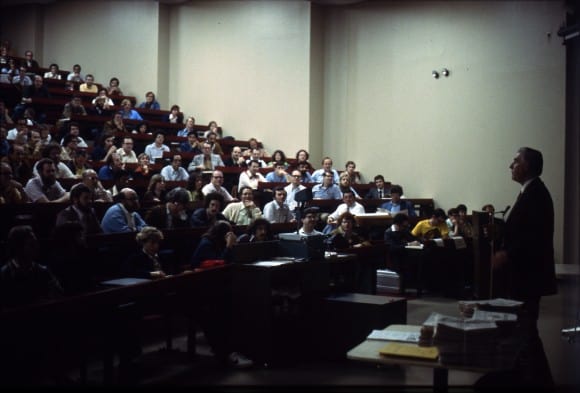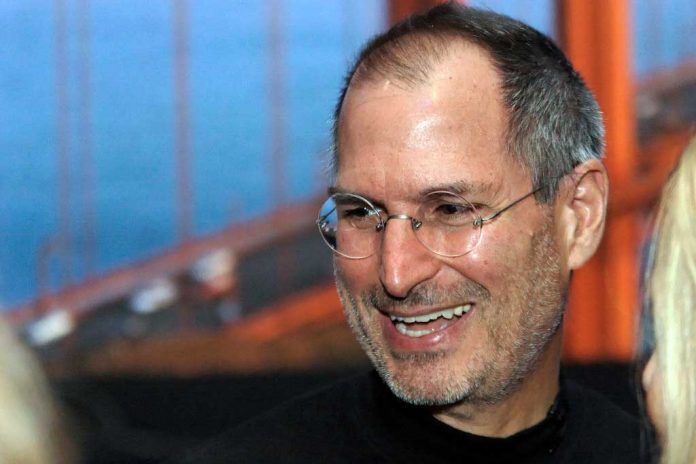As a teenager, Jobs and his older friend “Woz” cavorted in the “phone-phreaking” scene. Hackers such as “Captain Crunch” found out how one could manipulate the systems of telecommunications giant AT&T in order to make free calls with the help of a plastic whistle from a cornflakes package. Both Steves were electrified.

Woz constructed a crammed box from inexpensive electronic parts and a small speaker, which enabled them to produce tone sequences in a more precise and delicate way than with the toy whistle. “There used to be a way to fool the entire telephone system – they were thinking you were a telephone-computer,” recalled Steve Jobs later. “You could call anyone in the world for free. In matter of fact, you could call from a pay phone, go to White Plains, New York, take a satellite to Europe, take a cable to Turkey, come back to Los Angeles. You could go around the world – three, four times and call the pay phone next door. If you shouted into the phone, about 30 seconds later it came out the other end of the other phone.”
The manipulation of the telephone system was of course illegal. That did not stop Woz and Jobs from building and selling blue boxes within their circle of friends. “It was the magic of the fact, that two teenagers could build this box for a hundred dollars worth of parts and control hundred of billions of dollars of infrastructure in the entire telephone network of the whole world from Los Altos and Cupertino, California. That was magical,” said Jobs.
His friend “Woz” had even mor fun:
So we’re sitting in the payphone trying to make a blue box call. And the operator comes back on the line. And we’re all scared and we’d try it again. … And she comes back on the line; we’re all scared so we put in money. And then a cop car pulls up. And Steve was shaking, you know, and he got the blue box back into my pocket. I got it– he got it to me because the cop turned to look in the bushes for drugs or something, you know? So I put the box in my pocket. The cop pats me down and says, “What’s this?” I said, “It’s an electronic music synthesizer.” Wasn’t too musical. Second cop says, “What’s the orange button for?” “It’s for calibration,” says Steve.
— Steve Wozniak, lecture at Computer History Museum, 2002
With the “Blue Box” episode the business savvy of Steve Jobs began to sparkle for the first time. While Woz wanted to impress especially his geek pals, for his younger friend it was also about earning money and understanding that one can win big bets with small investment.
“Experiences like that taught us the power of ideas, the power of understanding that you could build this box, you could control hundreds of millions dollars worth of telephone infrastructure around the world. This is a powerful thing,” Jobs told many years later to Santa Clara Valley Historical Association.
If it hadn’t been for the Blue Boxes, there would have been no Apple. I’m 100% sure of that. Woz and I learned how to work together, and we gained the confidence that we could solve technical problems and actually put something into production.
In 1972 Jobs wanted to study at Reed College in the neighboring state of Oregon, although it was clear that his parents could not afford the university fees. “All savings of my working-class parents went for my college fees,” recalled Steve Jobs in June 2005 during his legendary commencement address at Stanford University.” After six months, I couldn’t see the value in it. I had no idea what I wanted to do with my life and no idea how college was going to help me figure it out.”
Search for the meaning of life
Jobs broke off his studies and made his way as a person making the best of things. Now and then he would get a hot meal at the local Hare Krishna temple. He sneaked into the calligraphy course, which was offered at Reed College. ” I learned about serif and I learned about serif and sans serif typefaces, about varying the amount of space between different letter combinations, about what makes great typography great. It was beautiful, historical, artistically subtle in a way that science can’t capture, and I found it fascinating.” This episode as well would later influence computer history:
Ten years later, when we were designing the first Macintosh computer, it all came back to me. And we designed it all into the Mac. It was the first computer with beautiful typography. If I had never dropped in on that single course in college, the Mac would have never had multiple typefaces or proportionally spaced fonts. And since Windows just copied the Mac, it’s likely that no personal computer would have them.
Steve Jobs was looking for the meaning of life. He experimented with mind-expanding drugs. At the time when he worked for Atari in 1975, he profited from a business trip to Europe to go to India on his own. At that time, Jobs was studying extensively the teachings of the Harvard professor Richard Alpert, who had converted to Hinduism and taught in India as Guru Ram Dass (“servant of God”). In India, however, Jobs found no enlightenment, but ended up with a scammer who was just playing the role of a guru. Disillusioned, he returned to California.

Meanwhile, his friend Steve Wozniak tried to impress a “strange, geeky group of people” who called themselves “Homebrew Computer Club.” “This was a group fascinated with technology and the things it could do. Most of these people were young, a few were old, we all looked like engineers; no on was actually good looking. Ha. Well, we’re talking about engineers, remember?”, Wozniak wrote in his book “iWoz”. Steve Wozniak developed a kit for the geeks from the club that would later be known as the Apple I. At that time, Steve Jobs was forging much bigger plans, as he had observed that very few people from Homebrew had the time or skills to build computers on their own. “Why don’t we build and then sell the printed circuit boards to them?”, he asked Woz. (iWoz, Page 172)

Read next page: Founding Apple Computer




[…] The Legend of Steve Jobs – His Life and Career » Mac History. Steve Wozniak and Steve Jobs […]
[…] time Apple has used an iconic design for an iOS app. The original iOS calculator used a design that paid homage to the classic Braun ET44 calculator. Apple SVP of Industrial Design Jonathan Ive is well-known as […]
[…] time Apple has used an iconic design for an iOS app. The original iOS calculator used a design that paid homage to the classic Braun ET44 calculator. Apple SVP of Industrial Design Jonathan Ive is well-known as […]
[…] time Apple has used an iconic design for an iOS app. The original iOS calculator used a design that paid homage to the classic Braun ET44 calculator. Apple SVP of Industrial Design Jonathan Ive is well-known as […]
[…] of German designer Dieter Rams defender simplicity and functionalism to inspire Steve Jobs and his Apple universe, in addition to Banzi, which would connect his brain chips from the first approach to […]
[…] Dieter Rams, defensor p la simplicidad junto con el funcionalismo que inspiraría a Jobs y a su universo Apple, además p a Banzi, que conectaría los chips p su cerebro a partir p ose primer acercamiento a la […]
[…] was the graphical user interface. I thought it was the best thing I’d ever seen in my life” (Steve Jobs 1995) Inspired by this amazing experience in 1983 Steve Jobs brought out “The Apple […]
[…] influenced the designers at Apple. See here and here. I’m not about to have a rant about the brazen similarities, its more to […]
[…] read about Steve Jobs and Dieter Rams. It talks about how Steve Jobs was highly influenced by the many years of work and design success […]
[…] Dernbach, Christoph. “The Legend of Steve Jobs – His Life and Career.” Mac History, Mac History, 1 Feb. 2015, http://www.mac-history.net/steve-jobs/2012-10-30/the-legend-of-steve-jobs-his-life-and-career […]
[…] Dieter Rams, defensor de la simplicidad y el funcionalismo que inspiraría a Steve Jobs y a su universo Apple, además de a Banzi, que conectaría los chips de su cerebro a partir de ese primer acercamiento a […]